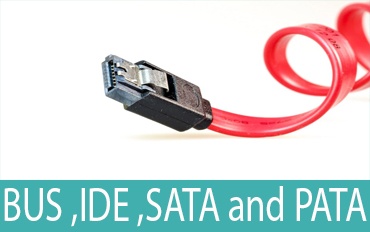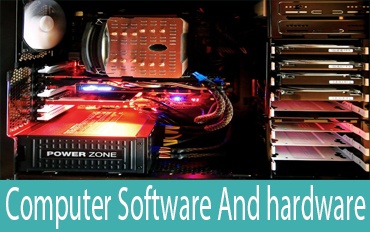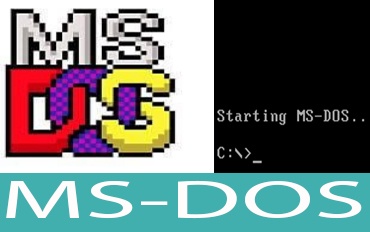BUS ,IDE Cables SATA and PATA
What is Computer bus ?
Computer bus, is a communication system that transfers data between components inside compute System.
Computer buses are group of lines that carries data,address or control signals.It is a subsystem that transfers data between computer components inside a computer or between computers.The CPU Bus has multiplexed lines, i.e., same line is used to carry different signals.The CPU interface is provided to demultiplex the lines, to generate chip select signals and additional control signals.
In computer architecture There are three types of buses,
Address bus :
It carries the address of a unique memory or input/output (I/O) device.The address bus is ‘unidirectional’.The size (width) of the address bus is specified by the number of bits it can handle.A 16 bit address bus is capable of addressing 65,536 (64K) addresses.
Data bus :
It carries data stored in memory (or an I/O device) to the CPU or from the CPU to the memory (or
I/O device).The data bus is ‘bi-directional’.Depending on the particular microprocessor, the data bus can handle 8 bit or 16 bit data.
Control bus :
It is a collection of control signals that coordinate and synchronize the whole system.The control bus is used by the microprocessor to send out or receive timing and control signals in order to coordinate and regulate its operation and to communicate with other devices, i.e. memory or input/output.
Types of computer buses
Internal bus or local bus
External bus or expansion bus
An internal bus also known as internal data bus enables communication between internal components of a computer, such as CPU and memory, to the motherboard .
An external bus is composed of electrical circuits which enable connection with external components such as a USB or SCSI device.
IDE Cables
IDE is Integrated Drive Electronics, is a standard type of connector in a computer.IDE is a types of cables which connect some hard drives and optical drives to motherboard, one end of cable is connected to motherboard and other end is connected to hard drive or optical drive
IDE cable have three connection in it , one is connect in motherboard and other two is for connecting drive.
SATA and PATA
PATA stands for parallel ATA.
SATA stands for Serial ATA.
There are two types of hard drive connections that a computer could have: Parallel ATA (PATA), and Serial ATA (SATA). Now a day we used SATA.
what is pata
PATA is capable of data transfers speeds of 66/100/133 MBs/second, whereas SATA is capable of 150/300/600 MBs/second. The max length of a PATA cable is 18-inches, whereas a SATA cable can be up to 3.3 feet (1 meter) in length.SATA cables are also smaller in size than a PATA cable.
what is sata
SATA is much faster than PATA.SATA drives are hot pluggable while PATA drives are not.SATA uses smaller cables than PATA.
SATA is the next generation storage interface for PCs and low-end Servers. The current Parallel ATA bus is not able to meet the increased bandwidth and performance demands of current and future PC designs.
This standard replaces the 26 position ribbon connector with a small flexible signal cable.
SATA can be directly connected (hot plugged) to motherboards and back planes similar to current SCSI applications eliminating the need for cable completely.
pata vs sata
• Parallel ATA uses a 40 pin ribbon cable
• Serial ATA uses a 7 pin connector and cable
Benefits of Serial ATA
The Serial ATA specification is designed to replace parallel ATA with a software transparent
interface for “inside the box” storage. It reduces voltage and pin count.
• Low voltage requirement. Serial ATA requires only 500 millivolts (mV) peak-peak to support new
silicon processes and higher integration.
• Lower pin count. Reducing the pin count helps reduce board real estate requirements and enables
more reliable connections on the board and the storage device.
• Higher integration. Unlike parallel ATA, Serial ATA does not require 5-volt tolerant transceivers that
can pose a hindrance to higher integration which utilize today’s and future silicon processes.
PATA History
| Generation | Standard | Year | Speed | Key Features |
| IDE | 1986 | Prestandard | ||
| ATA | 1994 | PIO modes 0-2, multiword DMA 0 | ||
| EIDE | ATA-2 | 1996 | 16 Mb/Sec | PIO modes 3-4, multiword DMA modes 1-2, LBAs |
| ATA-3 | 1997 | 16 MB/sec | SMART | |
| ATA/ATAPI-4 | 1998 | 33 MB/sec | Ultra DMA modes 0-2, CRC, overlap,queuing, 80-wire | |
| Ultra DMA 66 | ATA/ATAPI-5 | 2000 | 66 MB/sec | Ultra DMA mode 3-4 |
| Ultra DMA 100 | ATA/ATAPI-6 | 2002 | 100 MB/sec | Ultra DMA mode 5, 48-bit LBA |
| Ultra DMA 133 | ATA/ATAPI-7 | 2003 | 133 MB/sec | Ultra DMA mode 6 |
SATA History
| Generation | Standard | Year | Speed | Key features |
| Serial ATA | ATA/ATAPI-7 | 2002 | 150 MB/sec | |
| Serial ATA II | ATA/ATAPI-8 | 2004 | 300 MB/sec | Enhanced queuing |
| Serial ATA ? | ATA/ATAPI-9? | 2007 | 600 MB/sec |
You May Also Enjoy Reading This …








